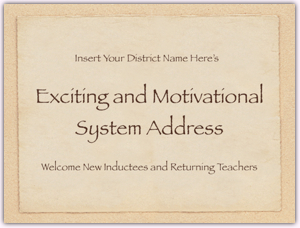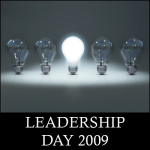Collaborating and Leading to Promote a Shared Vision 2
Establishing a vision to work towards is an important component of implementing and achieving positive movement forward. Without a vision, it can be all to easy to spend a lot of time doing a lot of things that don’t colletively contribute to anything. Without a shared vision, it can be truly difficult to “get all the ducks marching in the same direction,” or difficult to marshal and deploy the appropriate resources. And without a clear, shared vision, it can be difficult for stakeholders to have a sense what you’re all about, whether it is of any value to them, and close to impossible for them to know whether you’re achieving any success with it at all.
“You’ve got to think about big things while you’re doing small things, so that all the small things go in the right direction.”
— Alvin Toffler
 I recall my very first “new teacher induction meeting,” all those years ago (19, I think), when the then-Director of Education for the district assembled all of the new hires together during the last week of August (right about now, say) and welcomed us with a visionary and passionate speech about the careers upon which we were about to embark. I remember remarking at the time that he was one of the most eloquent and dynamic speakers I had ever heard, and was conscious at the time of his powerful use of metaphor and careful, poet’s choice of words in crafting his talk. I was impressed to the point that I was motivated to go up and speak with him when the session ended. (Imagine that, a new teacher, approaching the Director of Education on the first day of induction — and yet, why not?). Our conversation continued from the meeting room along the hallway, and concluded at his office, where he picked up a recently released book of essays on literacy from his desk and offered it to me to take away and use with my students. Imagine that. Welcome, and here’s a Vision, and here’s a Book of Inspiration.
I recall my very first “new teacher induction meeting,” all those years ago (19, I think), when the then-Director of Education for the district assembled all of the new hires together during the last week of August (right about now, say) and welcomed us with a visionary and passionate speech about the careers upon which we were about to embark. I remember remarking at the time that he was one of the most eloquent and dynamic speakers I had ever heard, and was conscious at the time of his powerful use of metaphor and careful, poet’s choice of words in crafting his talk. I was impressed to the point that I was motivated to go up and speak with him when the session ended. (Imagine that, a new teacher, approaching the Director of Education on the first day of induction — and yet, why not?). Our conversation continued from the meeting room along the hallway, and concluded at his office, where he picked up a recently released book of essays on literacy from his desk and offered it to me to take away and use with my students. Imagine that. Welcome, and here’s a Vision, and here’s a Book of Inspiration.
“Really great people make you feel that you, too, can become great.”
— Mark Twain“If your actions inspire others to dream more, learn more, do more and become more, you are a leader.”
— John Quincy Adams
Fast forward a bit, say three or four years later. Back then (in the olden days, before a goodly number of our Professional Activity days were removed by government decree in the mid-nineties) we used to have a designated “Federation Day,” which was a once-a-year opportunity for ALL of the teachers in the district to assemble in one spot for a day of teacher-provided sharing and self-selected workshops. I recall this one particular day, because yet again, the Director of Education (different director, mind) took the opportunity to speak to all of the assembled teachers (I’ll say perhaps 1 300 at the time). The wonderful impact upon me was again to reinforce that we, as a massed collective, newer and experienced teachers alike, were all working together to achieve a common vision. Again, powerful, motivating and, I think, important.
“If you want to build a ship, don’t herd people together to collect wood and don’t assign them tasks and work, but rather teach them to long for the endless immensity of the sea.”
— Antoine de Saint-Exupery“Nurture your mind with great thoughts, for you will never go any higher than you think.”
— Benjamin Disraeli
 Shortly thereafter we lost close to half of our PA days, and (regardless of that) never since have we had an opportunity to assemble as a whole district group to hear the Director speak and feel that common bond of pulling together with a shared and enumerated vision. The Director still has an address each August for the school administrators and central office staff, but it’s by invitation only, and the closest we get to it is the chance to download a narrated Powerpoint slide deck. Maybe this year’s address will be video recorded and posted for all to view, but somehow, something is lost without the face-to-face oration, without that opportunity to physically gather together and participate, and without that serendipitous moment to maybe have a chat with the Director.
Shortly thereafter we lost close to half of our PA days, and (regardless of that) never since have we had an opportunity to assemble as a whole district group to hear the Director speak and feel that common bond of pulling together with a shared and enumerated vision. The Director still has an address each August for the school administrators and central office staff, but it’s by invitation only, and the closest we get to it is the chance to download a narrated Powerpoint slide deck. Maybe this year’s address will be video recorded and posted for all to view, but somehow, something is lost without the face-to-face oration, without that opportunity to physically gather together and participate, and without that serendipitous moment to maybe have a chat with the Director.
So then
- Is this the norm within education organizations today?
- Is the collaborative development and sharing of a “big picture” direction part of your experience?
- How do you draw strength, support, and validation for the mission that you take to your classroom and your students?
- From whence comes your vision?




